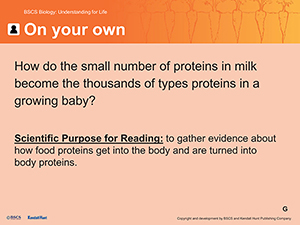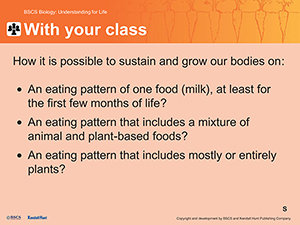CHAPTER 7 • LESSON 3 • INVESTIGATE
How does some matter from our food become part of our bodies?
PURPOSE | To figure out science ideas that help us toward answering our Driving Question by gathering and making sense of evidence.

TIME
Two 50-minute class periods
PREVIOUS LESSON | We figured out that food is mostly made up of three types of macromolecules and that some atoms from these macromolecules get incorporated into our bodies while others leave our bodies as waste. This left us wondering how atoms from some macromolecules are integrated into our body tissues.
THIS LESSON | We figure out that food that humans eat supplies the molecules needed to build and maintain the body. This leaves us wondering why not all atoms from food get used to build and repair the body.
NEXT LESSON | We will figure out how the body uses some molecules to make energy available for activity and life processes. This will leave us wondering how different eating patterns can meet all of our bodies’ requirements from food.
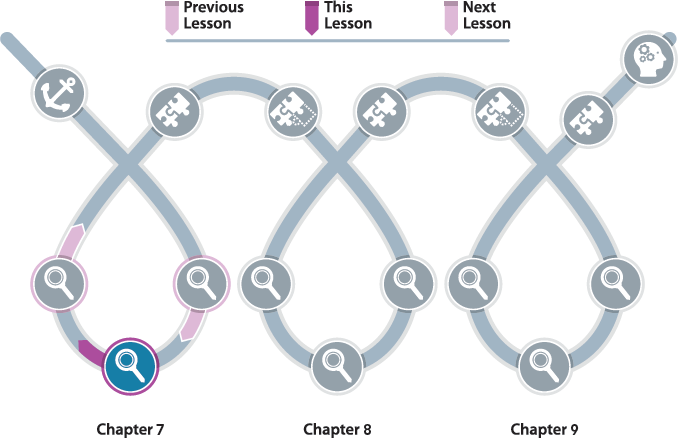
 LESSON LEARNING GOAL
LESSON LEARNING GOAL
Construct an explanation for how some matter from our food is able to enter and move within our body systems so that our body cells can rearrange the atoms from the food molecules to form body molecules.
Lesson question
How does some matter from our foods become part of our bodies?
What students figure out
Many food molecules are broken down in chemical reactions into smaller molecules in the digestive system.
Once broken down, food molecules can be absorbed into the cells of the small intestine. Then, these smaller molecules move into the bloodstream where they can circulate and be used as building blocks, and react to form a variety of new molecules.
Food molecules that are not broken down and absorbed continue to pass through the digestive tract and out the body.
What we are not expecting
Where we are not going yet
We are not yet investigating how different macromolecules are used to meet the body’s need for energy.
Boundaries
We do not expect students to figure out specific chemical reactions that underlie biosynthesis.
We do not expect students to figure out how nonessential amino acids are synthesized in the body.
-
We do not expect students to figure out the different mechanisms for absorbing food molecules beyond protein and carbohydrates (e.g., fats, nucleic acids, micronutrients).
We do not expect students to figure out mechanisms for how different molecules are transported into small intestine cells (e.g., active transport, diffusion).
We do not expect students to figure out how enzymes catalyze chemical reactions in the body.
We do not expect students to figure out the role of the lymphatic system in the absorption and circulation of nutrients in the body.
Relevant common student ideas
Students may believe that molecules in our body are directly absorbed and used in their original form from food, for example, that we need to eat animal muscle proteins in order to make our own body muscle, or that we need to eat raw enzymes from plants in order to get working enzymes in our own cells. (In the digestive system, molecules from food are chemically broken down into smaller molecules to be absorbed in the small intestine; these molecules from digested food are rearranged into new molecules needed in our bodies.)
Key literacy and sensemaking strategies
Reading Strategy: Student Choice
Students may choose to use the Reading Annotation Stems for reading texts and data representations. At this point, students should be familiar with using strategies such as the Science Close Reading Protocol and the I2 strategy to assist them with these tasks. Look for students to reach for these strategies as needed.
ASSESSMENT
Formative Assessment: Explanation
The explanation students develop is a good opportunity to informally assess students’ ability to synthesize information across lessons and texts.
The explanation students develop should synthesize information to make sense of how food provides matter for growth and repair. Look for students to focus on how and why mechanisms rather than descriptive repetition of details from the texts.
 INVESTIGATE LESSON SNAPSHOT
INVESTIGATE LESSON SNAPSHOT
Lesson 3: How does some matter from our food become part of our bodies?
BIG IDEA | Food that humans eat supplies the matter needed to build and maintain the body.
Routine |
Part |
Time |
Summary |
Slide |
Materials |
|
1 |
5 min |
Considering how food become us Students consider that we know foods are mostly made up of three main categories of molecules, but we don’t yet know how stuff in foods becomes part of us. Students wonder how the molecules in the food we eat become part of and transform into our bodies. Purpose: to motivate investigating how matter from food becomes “us.” |
A–B |
Science notebooks |
|
2 |
10 min |
Transforming a bottle of milk into a baby. Students gather information about the components of milk and a growing baby’s body in order to generate questions about how the molecules in a baby’s bottle transform into the molecules in a baby’s body. Purpose: to prompt the question of how matter in the digestive system can become part of our body cells. |
C–E |
Student Sheet 3.3.A: How does a bottle of milk transform into a baby’s body? |
3 |
25 min |
Proteins, from my plate to my body. Students use reading strategies to examine representations and texts about how protein molecules in food are digested, absorbed, and reassembled in the body. Students also gather evidence about how different food sources can meet our body’s needs for the different amino acids used to make body proteins. Purpose: to prompt the question of how food molecules from the digestive system get into the bloodstream to get to body cells; to gather evidence about how the molecules from different foods can be used to build body proteins. |
F–H |
Student Sheet 3.3.B: How does the body break down, absorb, and use proteins? Student Sheet 3.3.C: How can I get all the molecules I need to make body proteins? |
|
|
4 |
10 min |
Constructing an explanation. Students generate an explanation of how a simple diet with a single ingredient is able to meet a human’s needs from food at the start of life. Purpose: to build an explanation for how food can provide the necessary matter for growth and development. |
I |
Chart paper Markers |
Suggested class period break End of Day 1 |
|||||
|
5 |
10 min |
Investigating how sugars get into our bodies Students gather evidence to compare the digestion and absorption of proteins with carbohydrates. Purpose: to gain understanding of how large carbohydrates in food are broken down and absorbed into the body, and why some molecules in food are not available to become part of or to be used by our bodies. |
J–L |
Student Sheet 3.3.D: Moving carbohydrates from foods into the body |
6 |
10 min |
Investigating how milk sugars get into our bodies Students gather evidence about carbohydrate digestion by observing the product of lactase activity. Students figure out that glucose is not in regular milk until after a digestive enzyme has chemically rearranged other molecules to produce glucose. Purpose: to understand how large carbohydrates in milk are broken down and absorbed into the body and why some molecules in food are not available to become part of or to be used by our bodies. |
M–O |
Science notebooks Markers 2 index cards 1 bottle lactase drops 5 mL of regular cow milk 5 mL of lactose-free cow milk 2 test tubes, with caps, that can hold at least 20 mL of liquid Test tube rack 2 pipettes 4 glucose test strips (for urinalysis, not blood sugar test strips) |
|
7 |
10 min |
Investigating why milk makes some people sick Students use reading strategies to gather evidence about why some people are not able to digest milk. What happens to the large sugars that can’t be absorbed? Purpose: to build understanding of how human nutritional constraints and personal preferences vary across individuals. |
P–Q |
Student Sheet 3.3.E: Why does drinking milk make some people sick? |
|
|
8 |
10 min |
Putting together what we have learned. Students complete their Model Tracker entry for the lesson. Purpose: to track what we have figured out about how the matter in food becomes part of our bodies through our investigations. |
R |
Science notebooks |
9 |
5 min |
Generalizing how we can make our body molecules from different food molecules. Students consider why it is possible to sustain and grow our bodies on (1) an eating pattern with one ingredient (milk), at least for the first few months of life, (2) an eating pattern that includes a mixture of animal and plant-based foods, and (3) an eating pattern that includes mostly or entirely plants. Purpose: to capture what we have learned about how the matter in food becomes part of us, and how this informs our understanding of the societal issue. |
S |
||
10 |
2 min |
Designing meals for varied needs. Students reflect on their own experiences and observations: Does anyone in their community not eat dairy? Would we want to include dairy/non-dairy alternatives in a meal at our school (connecting to our Anchor Lesson)? How about for my family? Purpose: to reflect on how different food choices might relate to differences in individual preferences and physiology, as well as cultural contexts. To consider how what we have learned might inform our meal designs for different groups of people. |
T |
Science notebooks |
|
|
11 |
3 min |
Wondering about how we use sugars. Students wonder what happens to carbohydrates after they are in the bloodstream and available to body cells. We understand some “outputs” are atoms from food we could not digest, but why does our body “lose” other atoms in CO2? Purpose: to ask questions about how food molecules are used by the body beyond building new structures. |
U |
|
Suggested class period break End of Day 2 |
|||||
LESSON MATERIALS
Per student
Science notebooks
Student Sheet 3.3.A: How does a bottle of milk transform into a baby’s body?
Student Sheet 3.3.B: How does the body break down, absorb, and use proteins?
Student Sheet 3.3.C: How can I get all the molecules I need to make body proteins?
Student Sheet 3.3.D: Moving carbohydrates from foods into the body
Student Sheet 3.3.E: Why does drinking milk make some people sick?
Per class
Computer with projector
Markers
1 bottle lactase drops
5 mL of regular cow milk
5 mL of lactose-free cow milk
2 test tubes, with caps, that can hold at least 20 mL of liquid
Test tube rack
2 pipettes
2 index cards
4 glucose test strips (urinalysis test strips, not blood sugar test strips)
Per group
Chart paper
Preparation
Clear a space in your classroom for students to display chart papers.
Test run the lactase activity demonstration with your glucose strips and lactase drops before class. Different brands can perform differently, and you may decide to adjust the timing and quantities of milk and lactase drops accordingly.
Make copies of student sheets.
ADDITIONAL CONTENT BACKGROUND FOR THE TEACHER
While we often think of food as providing energy, which it does, food also provides the very matter that makes up our bodies as we grow, develop, and maintain all the structures making up our bodies. Aside from water, our bodies are mostly made of proteins, fats, and carbohydrates. Similarly, plant- and animal-based foods are mostly made up of proteins, fats, and carbohydrates, but not the exact same ones needed to make a human body. When we consume foods, chemical reactions occur that break these large molecules down into smaller subunits, which our bodies can then flexibly combine to create exactly the molecules it needs to live, grow, and repair.
 NAVIGATE
NAVIGATE
PURPOSE | To maintain coherence and continuity
Students prepare science notebooks for class.
Students should turn to a new page in their science notebooks and write a heading that includes the date and “Lesson 3.”
Students review their ideas from the previous lesson.
Display Slide A. Ask students to consider the ideas and questions we came up with in the last lesson. You might encourage students to look back in their science notebooks.
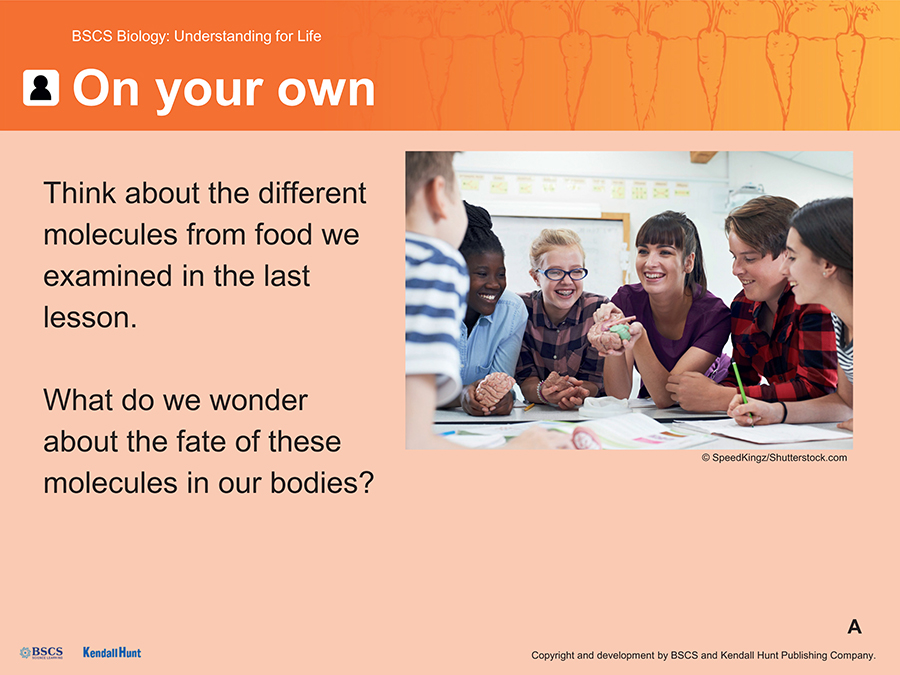
Students share their initial ideas about how food molecules become part of our body.
Display Slide B. Remind students that in Lesson 2, we figured out that food was made of different large molecules (macromolecules) and that some atoms from food are incorporated into our bodies. We wondered how atoms from food molecules became part of our bodies. Ask students to briefly discuss their initial ideas with a partner.
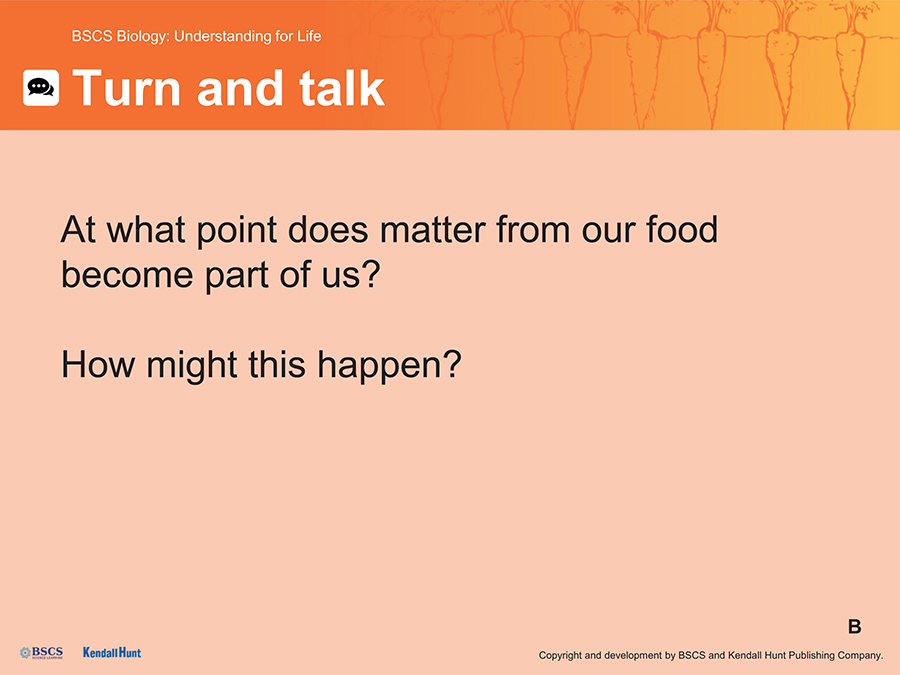
Students co-construct the lesson question.
Based on the preceding discussion, ask students what they think will be important to figure out next. Using their language, capture a question that is similar to: How does some matter from our food become part of our bodies? and write the question on a whiteboard or other publicly visible space. Have students open their science notebooks to a new page and write the date and “Lesson 3,” then record the lesson question on that page.
Students consider how a single-food diet can provide the necessary matter to support human growth and development.
Display Slide C. Remind students that in the Anchor Lesson, we noticed that people eat a wide variety of different foods. So how and why do humans begin life on a single-food diet: milk? Can this tell us anything about what we need from food and how we use it?
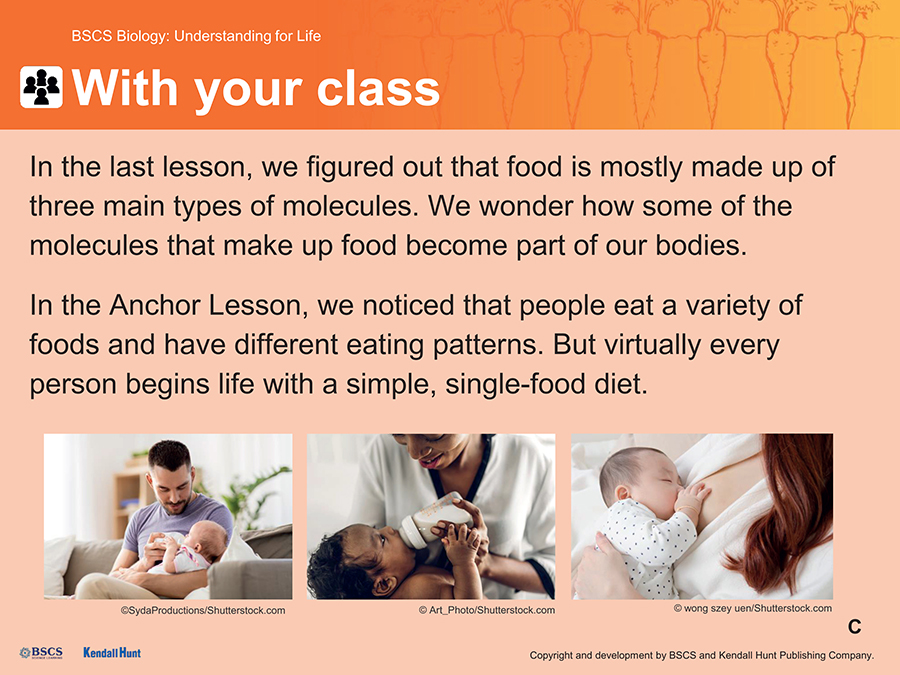
 GATHER EVIDENCE
GATHER EVIDENCE
PURPOSE | To plan and carry out evidence gathering tasks
Students gather evidence about how a bottle of milk can provide all the matter needed by a growing infant.
Display Slide D. Hand out a copy of Student Sheet 3.3.A: How does a bottle of milk transform into a baby’s body? to each student. Ask students to consider the prompt and Scientific Purpose for Reading as they read. Remind students that they are familiar with different reading strategies such as the Annotation Stems, Close Reading Protocol, and I2 strategy. Suggest that they consider if one or more of the strategies will support them as we gather evidence from this and other resources today.
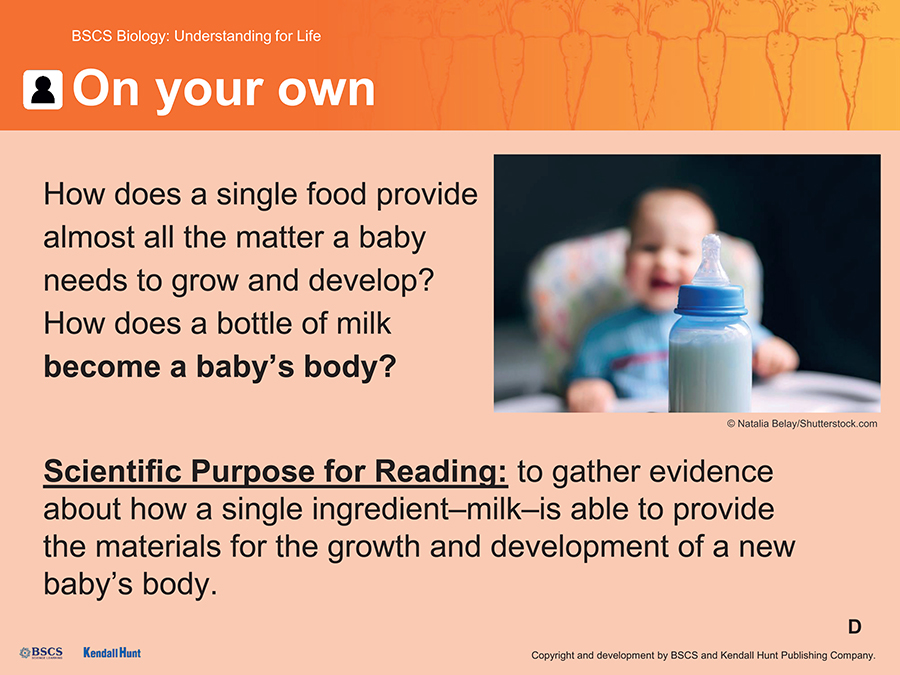
Students discuss what they noticed from the text with a partner.
Display Slide E. Ask students to briefly discuss the prompts with an elbow partner.
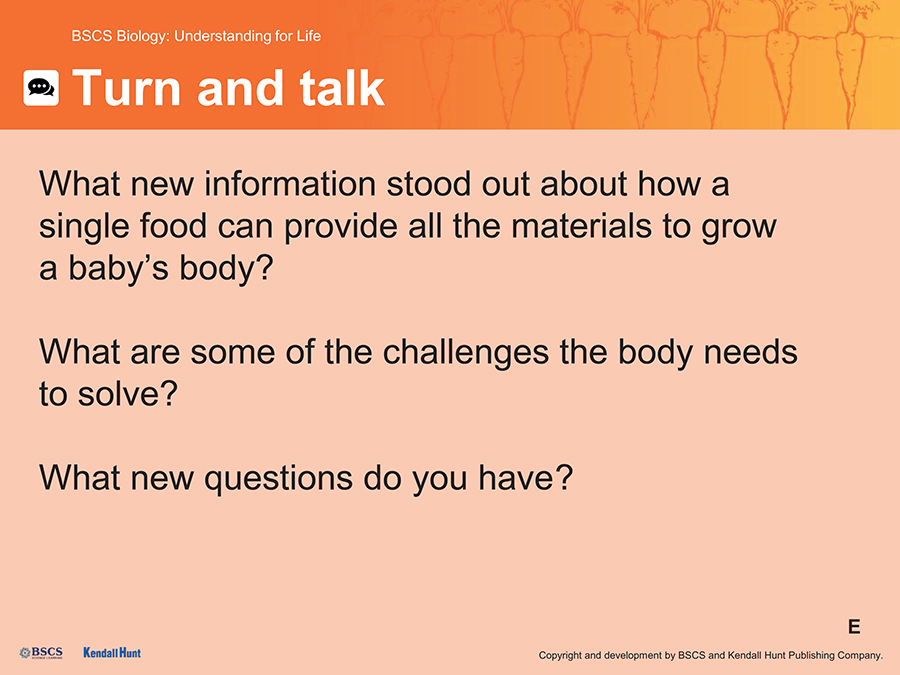
Ask partners to share their ideas and questions about how a bottle of milk becomes a baby. Listen for student ideas such as:
Milk is made of many different things.
Milk contains components that support a baby’s development, like sugars, proteins, and fats.
Milk has many types of things in it, but a baby’s body has even more types of things.
The types of molecules in a baby are different from the molecules in milk.
Babies can meet their food needs from milk for a while, but eventually they run low on micronutrients (iron) and need other foods.
Use students’ language to navigate to the next investigation, similar to: So, how do the components in milk become a much larger number of types of molecules in a baby’s body?
Common Student Ideas
Students may believe that molecules in our body are directly absorbed and used in their original form from food, for example, that we need to eat animal muscle proteins in order to make our own body muscle. Challenge students to consider the evidence in the table in Student Sheet 3.3.A about the different types of proteins present in milk compared to the baby’s body.
Students gather evidence about how the components of milk can become many thousands of new molecules in a baby’s body.
Display Slide F. Take a moment to revisit students’ ideas about the digestive system from previous learning. Ask students to share a few ideas about what the digestive system is made of and how it works.
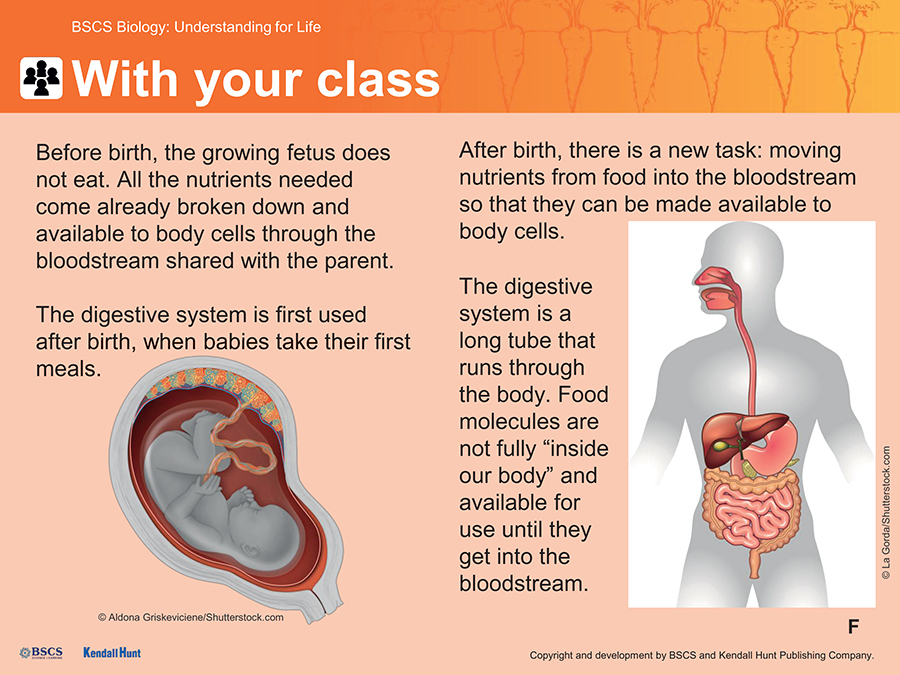
Explain that there is an important change in how a baby gets nutrients from before birth and after birth. Before birth, a fetus receives all the nutrients needed through a shared circulatory system with the parent. Once born, a baby has a new task of ingesting, breaking down, and absorbing molecules from food in order for body cells to be able to access these nutrients. Not only do babies need to turn 200 components in milk into thousands of types of body molecules, they need to first find a way to get these molecules into the bloodstream.
Since we know that babies have to turn material in milk into thousands of body proteins, maybe we can start by looking at how protein in food gets taken in and used to make body proteins.
Display Slide G. Hand out a copy of Student Sheet 3.3.B: How does the body break down, absorb, and use proteins? to each student. Remind students to consider which reading strategies might be useful for this set of text and representations.

Before transitioning to the next task, ask students to briefly share one main idea from the reading with their elbow partner. Listen for student ideas such as:
Proteins need to be broken into smaller parts to get into the bloodstream.
The broken down parts of food proteins are reassembled into new body proteins in the cell.
The digestive system has enzymes and acids that help dismantle food proteins into smaller amino acids.
We use 20 amino acids to make our body proteins, but we can only make some of them. The others we need to get from food.
Extension Opportunity
If your classroom has additional time and interest, you might consider integrating an investigation about how cheese is made. By adding either acid to heated milk or coagulants (like rennet, an enzyme derived from cow, sheep, or goat stomachs), students can explore how curdling milk causes proteins in milk to change shape and form a solid. This curdling helps slow the transit of protein in the gut, which enables these baby mammals to more fully digest and absorb proteins from milk. The cultural development of cheesemaking can also be viewed as a design solution, providing a means to reduce the weight (by removing water) and perishability of milk proteins in early dairying cultures.
Students gather evidence about how different foods can provide all the materials needed to build body proteins.
Display Slide H. Remind students that we noticed that eventually, all babies need to make the switch to eating a broader range of foods. We also noticed that not all foods contain all the amino acids we need to make our body proteins. Hand out a copy of Student Sheet 3.3.C: How can I get all the molecules I need to make body proteins? to each student. Ask students to consider the prompt and Scientific Purpose for Reading as they gather evidence from this text.

Extension Opportunity
The need for young children to transition to solid foods is shared across human populations, and many families have special ways to celebrate this transition and/or have traditions for which solid food is first introduced. If your classroom has time and interest, you might ask students if they know what solid foods they or other children in their family first ate and, if applicable, how their families celebrate the transition to solid foods for young children.
 GENERATE AN EXPLANATION
GENERATE AN EXPLANATION
PURPOSE | To build understanding from evidence
Students generate an explanation for how the components in food become part of the body.
Display Slide I. Hand out chart paper and markers to each pair. Ask students to work with their partner to develop an explanation for how the components of milk provide the matter needed for a baby to develop and grow. Encourage students to use words and/or pictures to depict their explanations. Visit students as they work, using the prompts below to push their thinking.
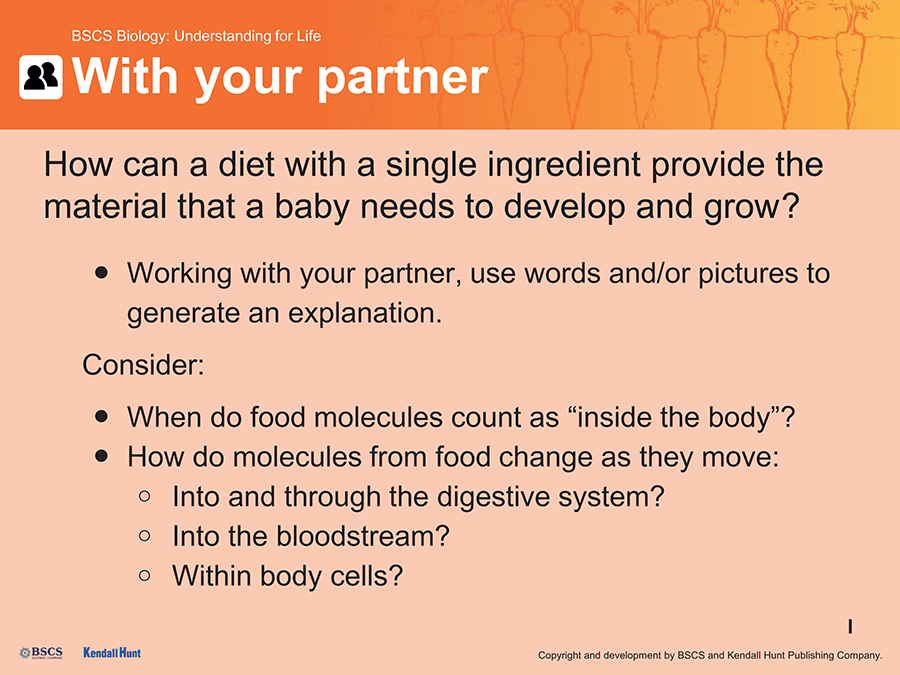
| Suggested prompts | Listen for student responses such as |
|---|---|
| When do the molecules in milk become part of the baby’s body? | Milk gets inside a baby when they drink, but the milk proteins aren’t part of the baby’s body until they are broken down into smaller parts to be absorbed. Later, the cells can reassemble these parts into new body proteins. |
| What changes about the food molecules as they are taken up and used by the body? What stays the same? |
|
Developing the Crosscutting Concepts: Energy and Matter
Students describe their current understanding of the pathway of matter originating in food molecules as they move into, within, and/or through the body. Students may describe how matter from milk components such as casein (protein), lactose (carbohydrate), or cholesterol (lipid) move into the digestive system. These molecules are broken apart and the atoms or sub-molecules are rearranged or reused to form other molecules (e.g., hemoglobin, glucose, or omega-3 fatty acids). As we trace matter, we see that these molecules then leave the digestive system.
Developing the Crosscutting Concepts: Systems and System Models
Students consider the boundaries between food being outside of, inside of, and/or part of the body system. Students may describe how milk components such as casein (protein), lactose (carbohydrate), or cholesterol (lipid) are inputs that move into the digestive system. These molecules are digested and the components are rearranged to form other molecules (e.g., hemoglobin, glucose, or omega-3 fatty acids). These products are outputs that then move out of the digestive system to another system such as the circulatory, respiratory, or nervous systems, where they are used for a variety of functions.
Developing the Practices: Constructing Explanations
Students begin to construct an explanation for how food molecules become body molecules using evidence obtained from the representations and texts examined so far.
Formative Assessment Opportunity
The explanation students develop is a good opportunity to informally assess students’ ability to synthesize information across lessons and texts to make sense of how food provides matter for growth and repair. Look for students to focus on how and why mechanisms rather than descriptive repetition of details from the texts.

SUGGESTED CLASS PERIOD BREAK
End of Day 1
 GATHER EVIDENCE
GATHER EVIDENCE
PURPOSE | To plan and carry out evidence gathering tasks
Students gather evidence about how carbohydrates are digested and absorbed.
Display Slide J. Remind students that we noticed that milk, particularly human milk, contains a lot of carbohydrates. We figured out how food proteins are digested, absorbed, and reassembled into body proteins. Do we digest and absorb carbohydrates in a similar or different way?
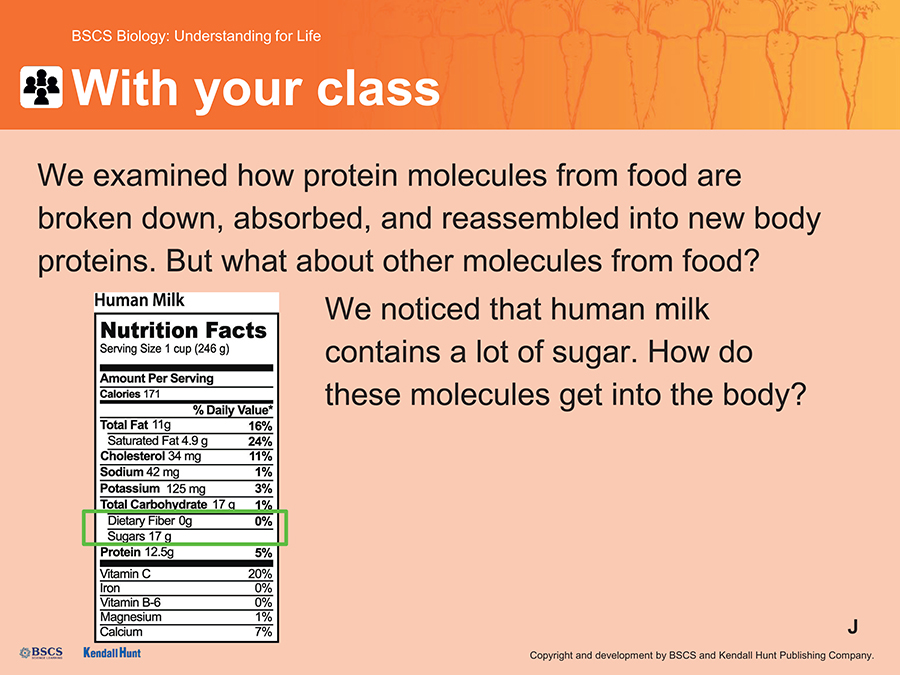
Ask students to share a few ideas.
| Suggested prompt | Listen for student responses such as |
|---|---|
| What ideas do we have about how carbohydrates get into the body? |
|
Students gather evidence about how carbohydrates move into, within, and/or through our bodies.
Display Slide K. Hand out a copy of Student Sheet 3.3.D: Moving carbohydrates from foods into the body to each student. Ask students to consider the prompt and Scientific Purpose for Reading as they gather evidence from this text.

Display Slide L. Ask students to discuss with an elbow partner what similarities and differences they noticed between how carbohydrates and proteins move into, within, and/or through the body.
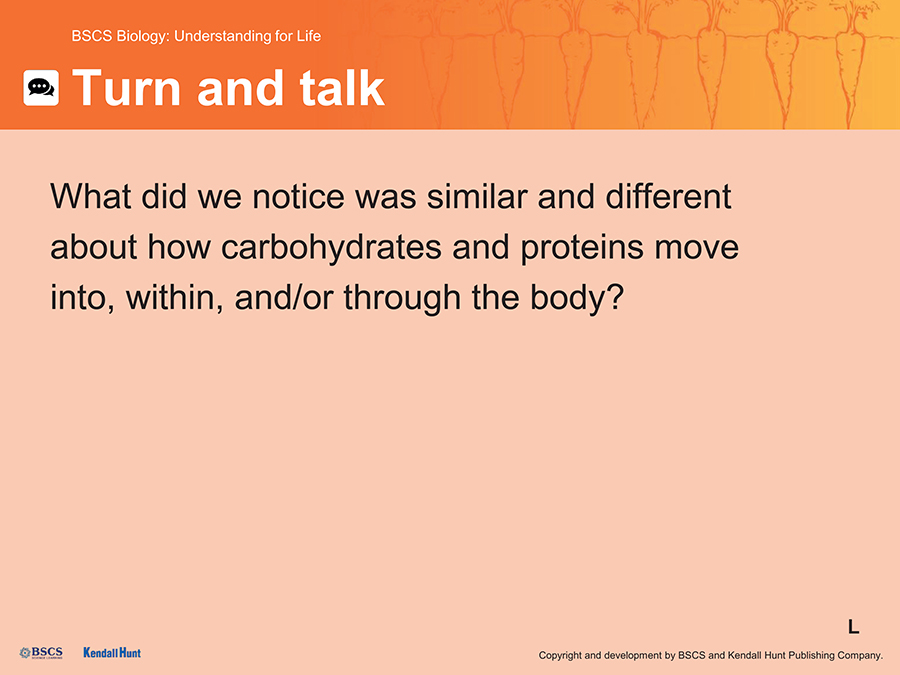
| Suggested prompt | Listen for student responses such as |
|---|---|
| What did you notice was similar and different about how our carbohydrates move into, within, and/or through the body? |
|
Developing the Crosscutting Concepts: Energy and Matter
Students describe their current understanding of the pathway of matter originating in food molecules as they move into, within, and/or through the body. Students may describe how protein and carbohydrates are forms of matter that are broken apart in the digestive system. These smaller components are either used to build new molecules that are moved to other systems in the body–or as they know from Lesson 2, some leave the body as waste and others as CO2).
Students gather evidence about how milk sugars move into and/or through the body.
Display Slide M. Remind students that we learned that lactose is the main sugar in milk, and that two-unit sugars like lactose cannot be directly absorbed unless they are broken into smaller sugars. We also learned that babies need a lot of glucose as a source of fuel to support their developing brains. How can babies get these larger milk sugars into their bodies in a form they can use?
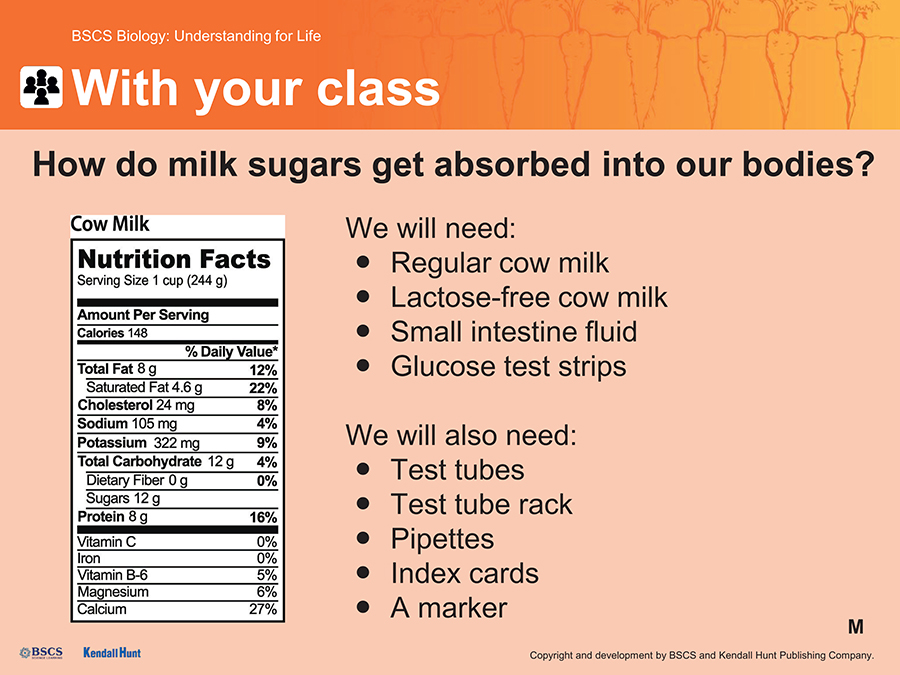
Let students know that there is a way to simulate a digestive system to see if we can turn the sugars in milk into a form our small intestines can absorb. To do this, we can use two types of cow milk to simulate what might be happening in a baby’s digestive system: regular cow milk and something called “lactose-free” milk. You also have some “small intestine fluid” drops and a special test strip that can measure glucose, a small single-unit sugar we know we can absorb.
Label your two test tubes: Regular and Lactose-Free. To the Regular test tube, add 5 mL of regular cow milk. To the Lactose-Free test tube, add 5 mL of lactose-free milk. Set the test tubes into your test tube rack.
Label two index cards: Before and After. For each card, write Regular on the lower left side and Lactose-Free on the lower right side. This will provide a place for you to set down and keep track of the glucose strips while you are waiting for the results.

Display Slide N. Let students know that we will be testing each of the two milks for glucose before and after adding our small intestine fluid drops. Ask students to copy down the chart into the science notebooks and make a prediction about which samples, if any, will test positive for glucose. They should make four predictions in total.
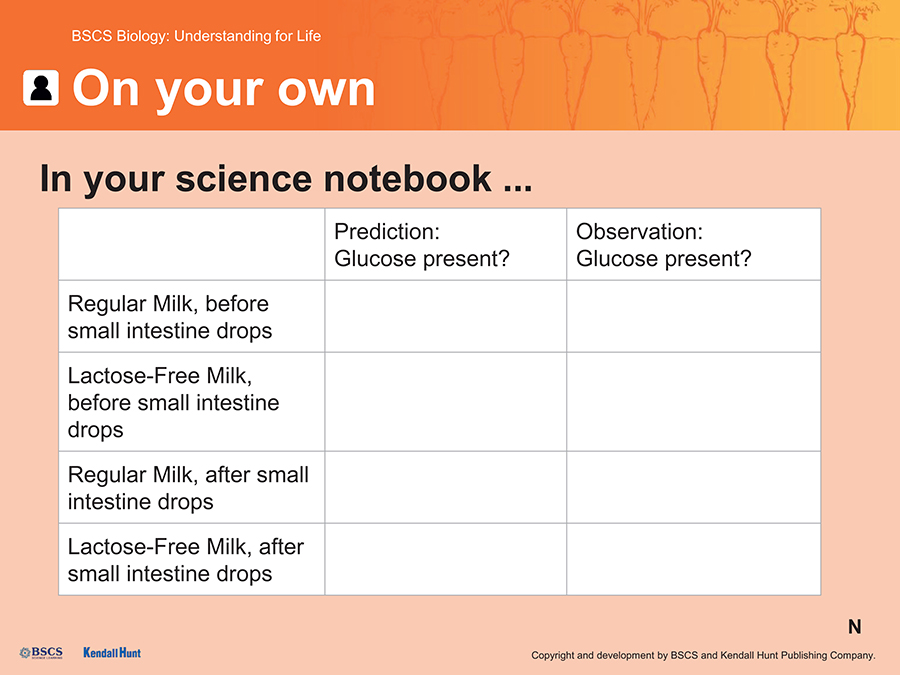
After students have marked their predictions, dip a glucose strip into each of the two test tubes for 2 seconds and set each strip on the corresponding labeled corner of the Before card. Set a timer for 2 minutes to wait for the results. Take care to keep your fingers clean and dry throughout handling these materials, as cross-contamination could impact the results.
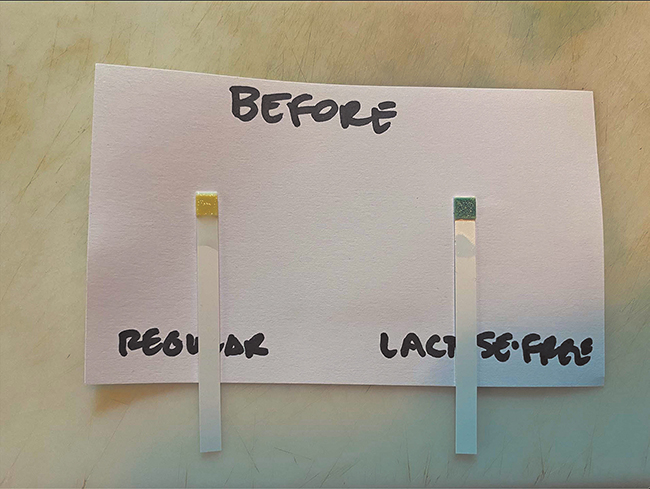
Ask students to share what they observe and to mark their charts. Let students know that, to simulate activity in the digestive system, we will add a small amount of the small intestine fluid, and then gently warm and mix the solution in our hands, simulating the conditions of the small intestine. You might ask two students to hold and gently roll the capped test tubes.
Then, add two drops of lactase solution into each of the two test tubes. Cap each of the two test tubes and roll them between your hands for 2 minutes. Then, carefully return the test tubes to the tube rack. Using fresh glucose test strips, dip a glucose strip into each of the two test tubes for 2 seconds and set each strip on the corresponding labeled corner of the After card. Set a timer for 2 minutes to wait for the results.

Ask students to share what they observe and to mark their charts.
Extension Opportunity
If your classroom has additional time, you might consider adapting this demonstration into a small group investigation. With additional time, students could manipulate variables like heat or acidity to investigate whether these factors impact lactase activity. You might also investigate the effect of lactose drops on a sucrose solution. Students could deepen their understanding of enzyme specificity by figuring out that lactase is only able to split lactose, not all two-unit sugars.
Display Slide O. Ask students to share what they notice and wonder with their elbow partner.
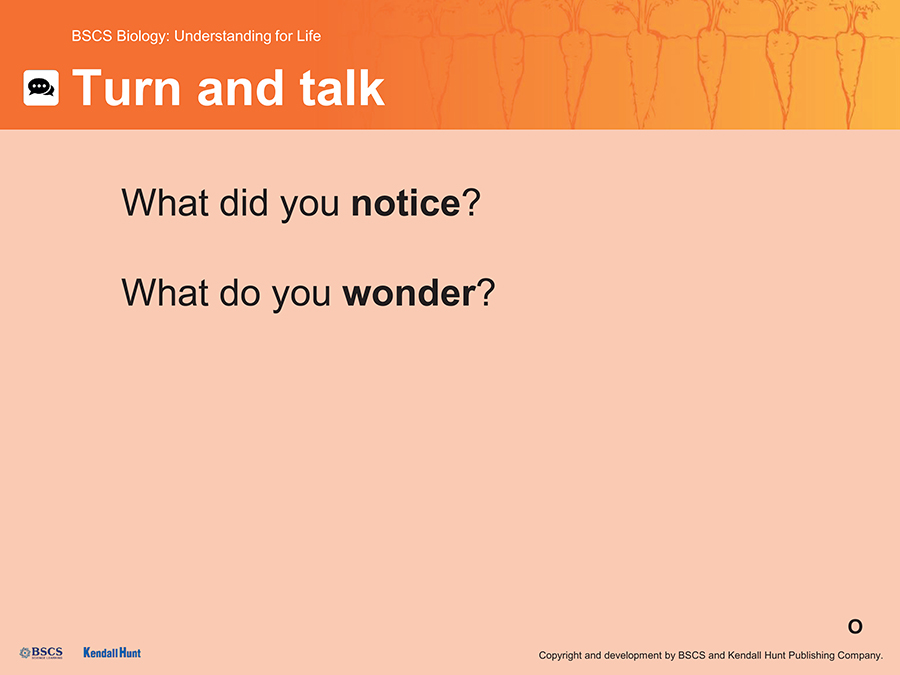
| Suggested prompts | Listen for student responses such as |
|---|---|
| What did you notice and wonder about in this simulation? |
|
| Which of the milks do you think had lactose sugar in it? When? |
|
Students consider how people vary in their ability and desire to drink dairy milk.
Display Slide P. Refer to students’ ideas and questions, highlighting ideas and wonderings about how glucose appeared in the regular milk and why some people may not be able to drink regular milk. Share that the small intestine drops contain an enzyme called lactase that is able to split lactose into two smaller sugars. These can be bought as pills or drops in most grocery stores, as can lactose-free milk. But what are these things, and why are there often so many different kinds of milks in the store?
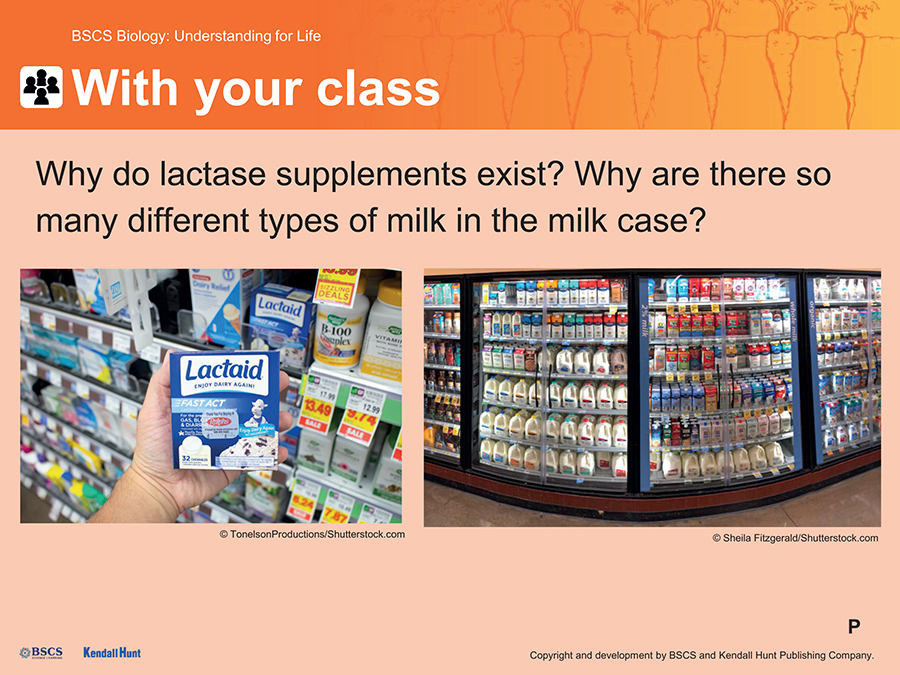
Display Slide Q. Hand out a copy of Student Sheet 3.3.E: Why does drinking milk make some people sick? to each student. Remind students to consider which reading strategies might be useful for this set of text and representations.
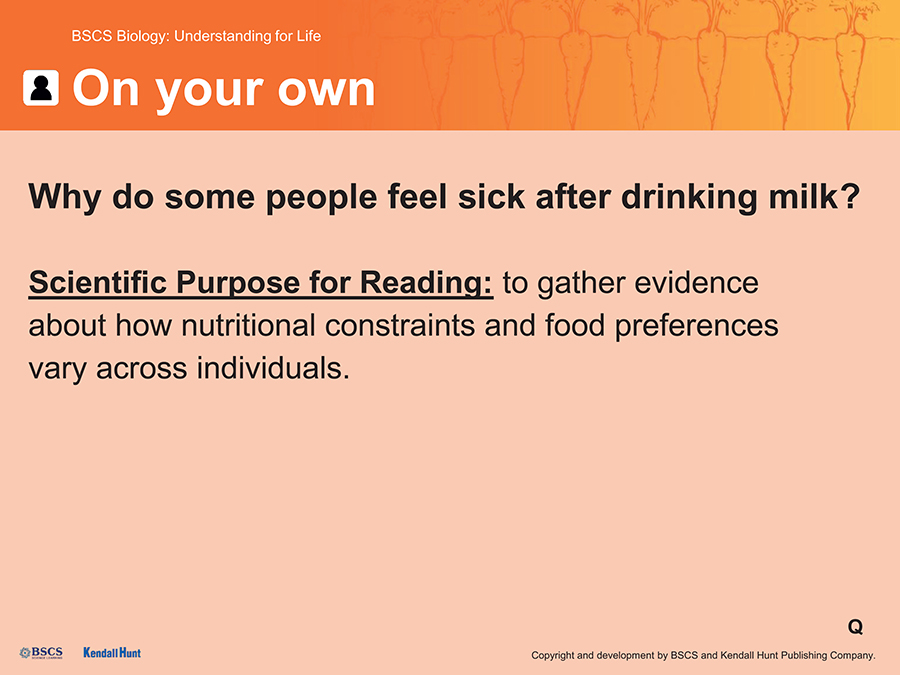
Support for Literacy and Emerging Multilingual Learners
Lactose (the sugar) and lactase (the enzyme that breaks it down) look and sound extremely similar, but have different meanings. If students are not clear which is meant, they may have trouble making sense of classroom discourse. Remind the class that it is important to address language challenges and work with the class to use context to decide how to add both terms (as terms we encounter) to the Word Wall. Consider seeing if students want to set a norm of either revoicing to double-check or asking directly which one is meant when a peer is speaking.
 GENERATE AN EXPLANATION
GENERATE AN EXPLANATION
PURPOSE | To build understanding from evidence
Students add a new entry to their Model Tracker.
Display Slide R. Using the pages set aside in their science notebooks, students should create a title for the Model Tracker for Lesson 3 with the question we are working to figure out. Then, discuss as a class what ideas we have figured out from all our investigations during this lesson, and add them to the Model Tracker.
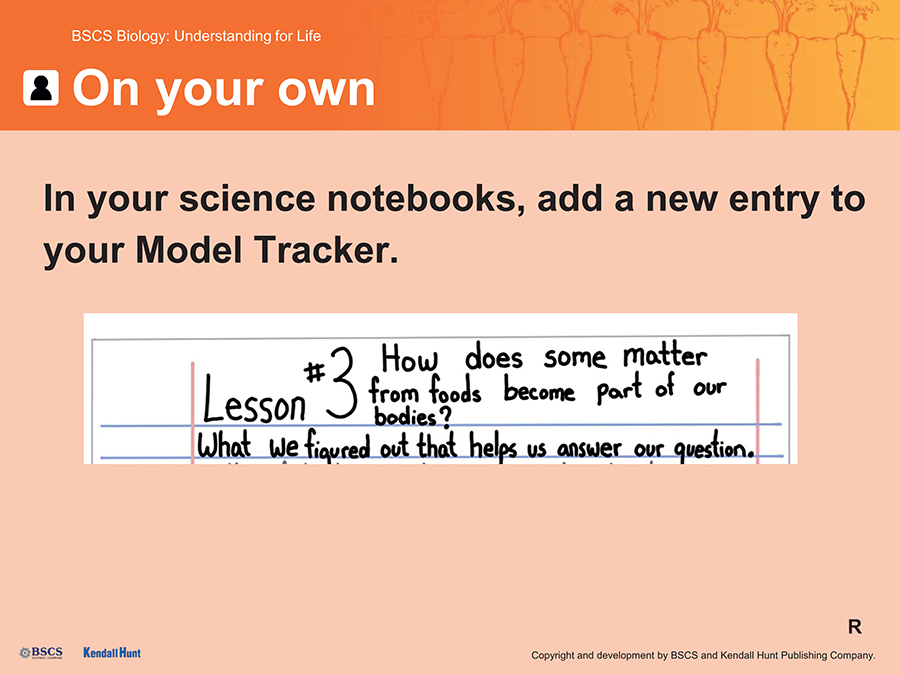
Suggested prompts:
What was the question we were trying to figure out in this lesson?
What were some of the things we figured out in connection to the lesson question?
If we were going to put some of these ideas in a model, how might we represent them?
After a brief discussion students work independently to complete their Model Tracker entries. They sketch their ideas about how some matter in our food becomes part of our bodies.
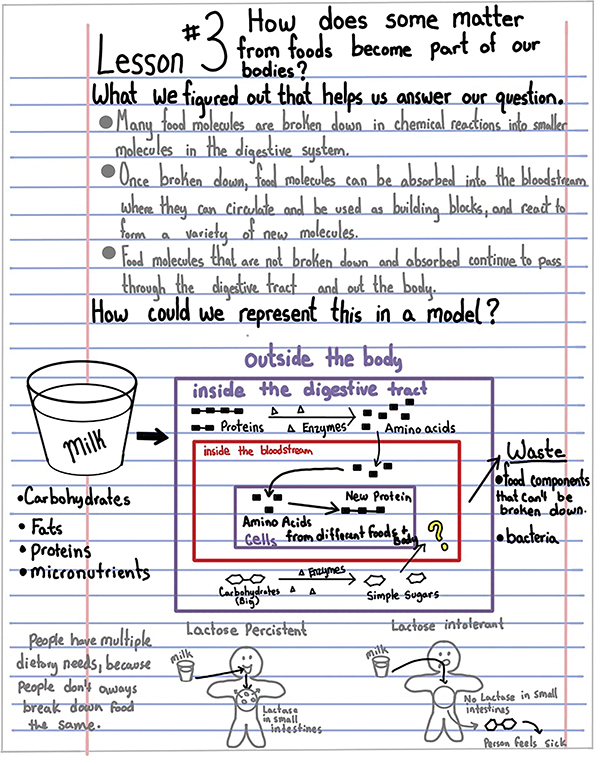
Potential student response (representations will vary; drawing quality is not important, only the ideas conveyed).
Students discuss how we are able to get the matter we need to build our bodies from a variety of sources.
Display Slide S. Ask students to discuss the prompts and record student ideas. Use the following prompts to deepen the discussion:

| Suggested prompts | Listen for student responses such as |
|---|---|
| How does what we eat become part of our bodies? | We break down food molecules into smaller parts to get them into our bloodstream, and then our body cells can reassemble those small molecules into larger molecules, like proteins. |
| How can humans meet their body’s needs for matter from very different diets? | We break down our food into smaller parts and build our new body molecules from those parts. As long as the foods we eat contain all the essential building blocks we need, we can reassemble them into our own body molecules. |
| What have we figured out about why some stuff in food does not become part of our bodies? |
|
Once students have voiced the idea that our body breaks down a variety of molecules from food and uses the building blocks to build its own molecules, needed for its own specialized structures, tell students that scientists call this biosynthesis. Work with the class to add this “earned” word to the Word Wall.
Developing the Practices: Obtaining, Evaluating, and Communicating Information
Students integrate evidence gathered from different texts, representations, and demonstrations in order to address the lesson question: How does some matter from our foods become part of our bodies?
Students connect their learnings back to the Anchor Lesson.
Display Slide T. Ask students to use words or sketches to individually reflect on the prompts in their science notebooks.
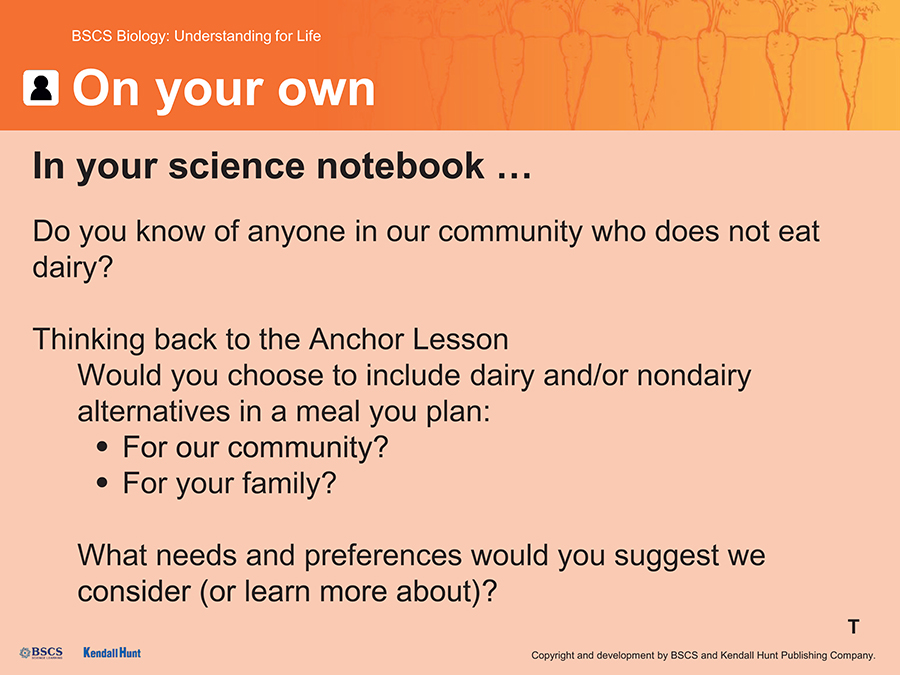
 NAVIGATE
NAVIGATE
PURPOSE | To maintain coherence and continuity
Students wonder about why we lose some matter if molecules in food are so useful.
Display Slide U. Using ideas and questions that students have surfaced, remind students that we have figured out that we can rearrange atoms in the molecules from food in order to make new body molecules, and some molecules travel through and out of our digestive system because we cannot break them down. Remind students that in Lesson 2, we noted that there are other ways we lose matter, like carbon dioxide in our breath. But if the atoms in food molecules we can absorb are so useful, why do we lose some of them?
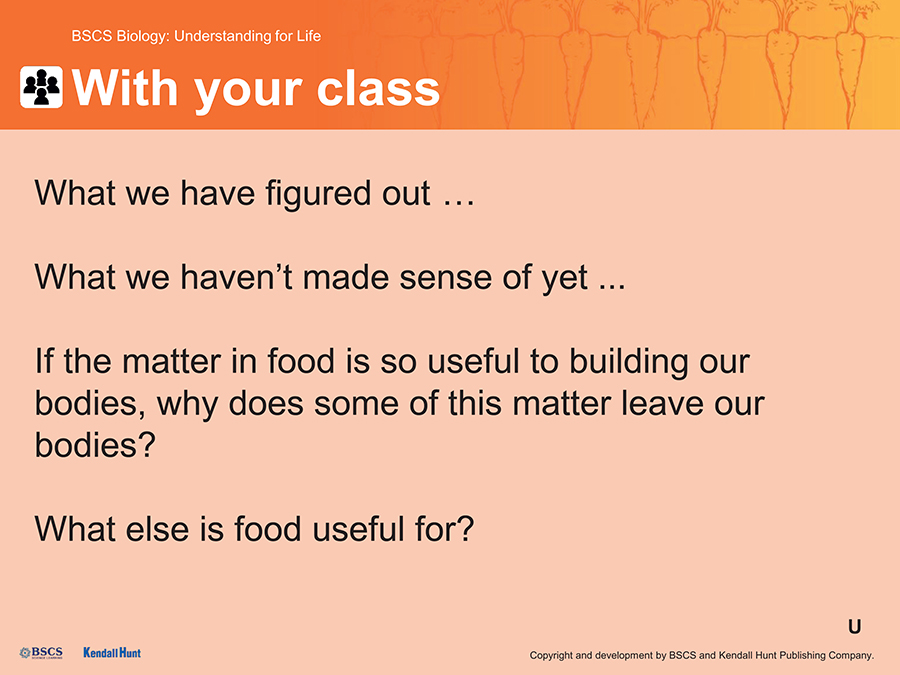

SUGGESTED CLASS PERIOD BREAK
End of Day 2
REFERENCE
Gerbault, Pascale, Anke Liebert, Yuval Itan, Adam Powell, Mathias Currat, Joachim Burger . . . Mark G. Thomas. “Evolution of Lactase Persistence: An Example of Human Niche Construction.” Philosophical Transactions of the Royal Society of London. Series B, Biological Sciences 366, no. 1566 (2011): 863–877. https://doi.org/10.1098/rstb.2010.0268. (Student Sheet 3.3.E).









